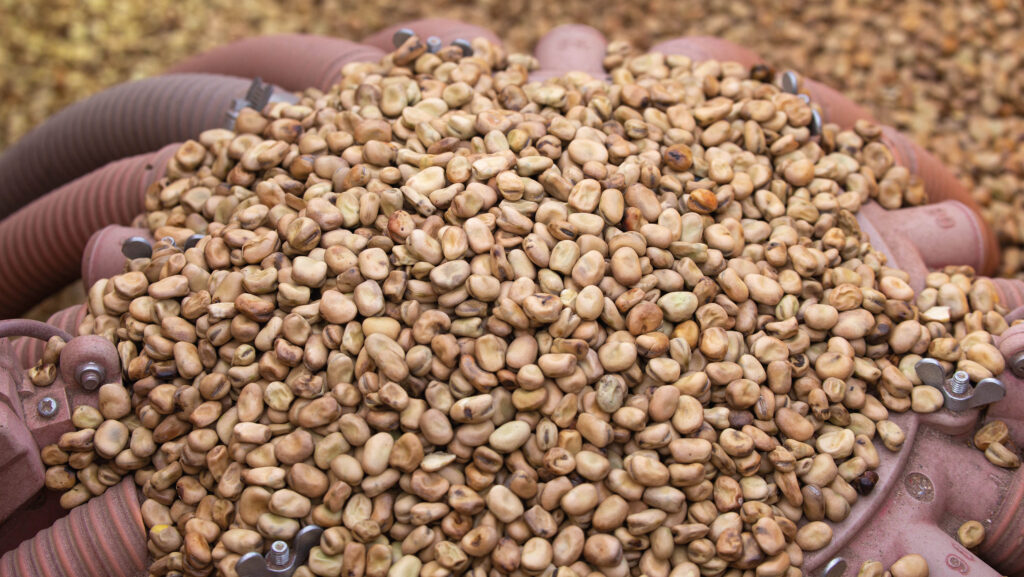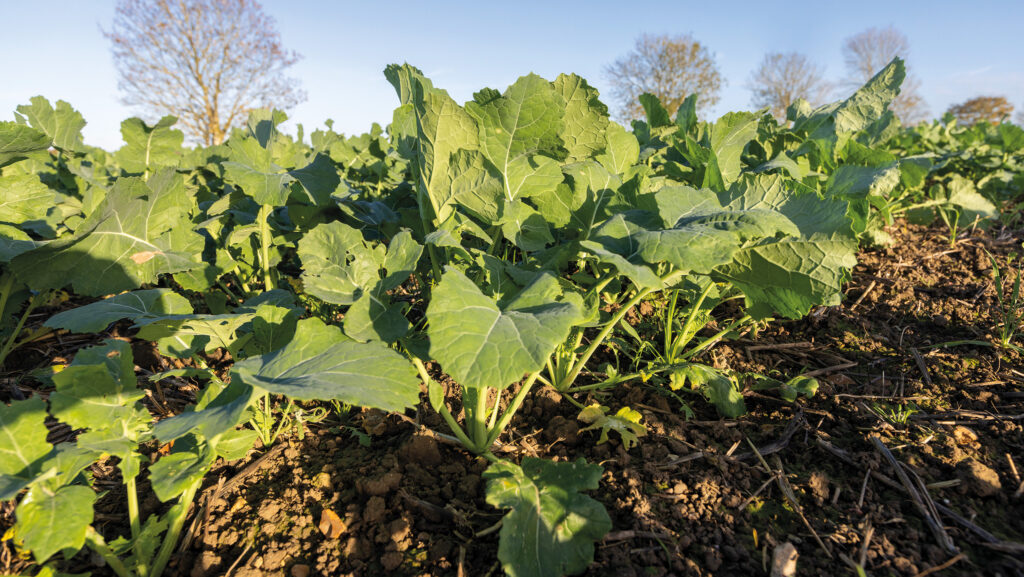Crop Watch: Bean drilling and propyzamide sprays in OSR
 © Tim Scrivener
© Tim Scrivener Winter bean drilling is progressing well, especially in the South West where conditions are ideal with good seed-beds.
The arrival of cooler weather this week means the time is approaching to apply propyzamide with or without aminopyralid to oilseed rape crops, especially as the milder autumn has seen weeds
See also: New winter malting barley variety granted full brewing approval
West
Ben Allard
Pearce Seeds (Dorset, Wilts and Somerset)
At last, the weather has been kind to us in the West over the past two weeks and significant progress has been made with drilling and spraying, with many now near the finish line.
Many growers have had to adapt their original cropping plans based on soil conditions, with wetter land now designated for spring cropping.
The weather has also been unseasonably warm, which is beneficial for later emerging cereals, but has led to a high population of aphids, including vectors of barley yellow dwarf virus.
Attention to integrated pest management (IPM) practices, such as T-sum models or monitoring beneficial activity around the crop, is vital to help determine whether the use of insecticides is necessary.
As a result, post-emergence applications of aphicides like esfenvalerate have been applied, along with foliar feeds to maintain healthy crops going into winter.
Additionally, post-emergence herbicides have been applied where pre-emergence applications were missed or a top up of active ingredients such as flufenacet, to help control ryegrass and blackgrass.
Seed-beds have been far from perfect this season and, as a result, this has had a clear impact on the effectiveness of pre-emergence herbicides, which have not performed as well as in previous years.
While conditions are generally good, it is worth monitoring for persistent grassweeds that may require additional targeting.
Maize harvest
In my previous Crop Watch update, I referenced the difficulties of this season’s maize harvest.
Most growers in the West have now nearly finished, thanks to the recent dry period.
Following two wet autumns back-to-back, many questions must be asked about where we grow maize.
Field selection is becoming increasingly important to mitigate excessive damage to soil structure, reduce environmental impacts, and ensure a less stressful harvest.
Marginal land is becoming more marginal due to weather conditions, and the use of Sustainable Farming Incentive (SFI) options or a switch to spring cereals could provide a viable alternative to growing maize on such marginal land.
Winter beans are being sown into excellent seed-beds, with conditions in the West being ideal.
My growers who are planting winter beans do not face high grassweed pressure, so herbicide choices are centred on Nirvana (imazamox + pendimethalin) and Mohawk (clomazone), along with pre-emergence adjuvants to enhance the quantity and longevity of residual herbicide.
With limited options for post-emergence applications in winter beans, I always recommend using robust rates and not cutting back in order to get it right the first time.
As the winter months approach and the gates close until spring, this will be a time for a well-earned period of rest and reflection on the past year, which for many has been challenging and testing.
South
Neil Harper
Agrii (Kent)
With all the challenges surrounding farming, it is nice to have some positives. Field work has been getting on, drills have been running, and generally, seed-beds have been good.
Most have finished autumn planting, with the rest close to completion.
Soil temperatures are low enough to consider propyzamide applications in oilseed rape.
Grassweeds are growing rapidly, and their roots are getting deeper. In this situation, propyzamide will need to be applied as soon as possible for the best results.
Slugs are still floating around in oilseed rape. The levels differ between fields; there is no apparent reason why, meaning field-by-field assessments are required.
Traps have been used to monitor levels, and we are aiming not to chase the slug pressure because that can be a dangerous place to be in, especially with ferric phosphate slower to act than metaldehyde.
This is true for cereals as well as oilseed rape. We are about 95% complete with autumn cereals planting.
However, few crops have been rolled to consolidate the seed-bed, posing a risk of seed hollowing, and we have also seen grazing of wheat crops up to three true leaves.
Despite the slugs, we are delighted to be in the position of managing drilled cereal crops rather than bare ground.
Seed-bed quality ranges from very good to challenging, with the trickier fields putting pressure on decision-making for herbicide programmes.
Do we stay pre-emergence and risk stressing crops or go post-emergence?
Where a compromise needs to be made, we prefer to alter the timing rather than the herbicide choice.
We know some products are stronger than others, and we want to use the best chemistry in a grassweed scenario.
A herbicide like cinmethylin gives us the option to go peri or post-emergence and still be confident of reasonable control.
Aphids
Early-drilled cereals look excellent, but we are seeing high aphid numbers, and T-sum calculations tell us that the second generation of aphids is due.
Where we have sprayed insecticides, we have included additional nutrition.
Winter bean drilling has also progressed well.
The catchy conditions have allowed farmers to get on with fields destined for beans and allow more time for wheat seed-beds to dry out before moving onto them.
Herbicide programmes heavily rely on pre-emergence applications, and we are pleased to have the additional option of aclonifen this year.
Hopefully, this will provide further control of broad-leaved and grassweeds.
This season has reminded me of the resilience of farmers; they see a problem and figure out how to solve it.
This has helped them to come out the other side of another challenging autumn with a positive outlook.
Chris Leslie
AICC/Cloud Farming
Groundswell (central and southern Scotland)
The countdown to Christmas is already under way in our household, and it’s a welcome change of focus.
With most crop applications wrapped up for the season, there’s time to take stock.
It’s satisfying to see cover crops doing their job – fixing nitrogen, improving soil structure, and holding the soil in place – all without the need for constant input.
There’s something reassuring about the way nature steps in when you let it.
That said, it hasn’t been a completely smooth season.
Yellow rust in winter wheat has gone wild in a few fields, but with colder nights now settling in, it should calm down, but if not, it might be time to let the sheep have their turn early in the New Year.
Meanwhile, Astro Kerb applications have been a talking point. A reminder to operators: washouts are critical.
The active ingredient, aminopyralid, is potent even in small amounts and can wreak havoc on sensitive crops like beans and peas.
Plus, there are restrictions on baling straw – definitely something to bear in mind.
Meeting season
Meeting season has begun, and with it comes a flood of ideas and products to consider.
Some of the offerings – like “bugs in a jug” – seem promising, but their efficacy often depends on getting the basics right first.
Healthy soil structure and thoughtful cultivation practices are the foundation, and without them, it’s like building a house on sand.
That said, there’s value in piecing together the jigsaw of innovations and time-tested techniques to find what works on your land.
Nitrogen remains a key focus, and maximising its efficiency requires sticking to the fundamentals.
Apply it in a month with an R in it to avoid building protein in the plant at the expense of yield.
Grain testing has become one of the most reliable tools in the shed for figuring out what’s worked this season and what hasn’t.
Last week, I attended the AHDB Recommended List (RL) Wheat Committee.
The data is as rich as ever, and while the list’s primary job is to compare varieties against a comparator it also holds a lot of other potentials, each variety in theory can be given an N optimum from the grain protein testing as part of the RL standard testing process.
The grain protein bearing a direct relationship with nitrogen shows the actual protein potential achieved from an RB209 standard fertiliser protocol.
This could help refine practices – especially if nitrogen taxes become a reality.
There’s always more to learn, and with every meeting, trial, and season, I can’t help but wonder – will we ever complete the jigsaw?
East
Harriet Bateman
Prime Agriculture/AICC (Norfolk, Cambs and Lincs)
As we head into winter, autumn crops have a lot more potential than we could have hoped for a few weeks ago.
About 95% of the winter wheat is now in the ground with the drill just following the sugar beet harvester or attempting to re-visit that odd wet hole which never seems to dry.
While conditions are good and where flushes of blackgrass have already appeared some growers are making use of the dry weather to drill winter wheat rather than a spring crop.
However, before committing to additional drilling over that originally planned it is worth taking time to consider the knock-on effect on rotations and operations next harvest.

© GNP
Where you decide to carry on with late drilling it is important to monitor seed-beds carefully and adjust seed rates and planned herbicide programmes accordingly.
Residual herbicides require a layer of soil between the seed (a minimum of 32mm on most products) for crop safety.
Some of the more soluble actives require extra attention as these are more likely to lead to crop damage, and in some cases products lose pre-emergence approval as we move later into the autumn.
Always read the label to avoid being caught out. In some cases, it might be safer to treat post-emergence once the crop has put some roots down and popped its head above the ground.
BYDV
As we move towards the end of the month the forecast is predicting a drop in temperature, especially overnight.
This means it is likely the later drilled crops will not reach the critical timing for barley yellow dwarf virus treatment (BYDV) (a T-Sum of 170) and, therefore, not require an insecticide spray, but it is important to record emergence dates and keep checking for the presence of aphids.
Cooler weather will also give the opportunity to apply propyzamide with or without aminopyralid to oilseed rape crops. When applying pay close attention to stewardship.
As this is likely to be the last trip through the crop this year, review any requirement for additional disease control and the need for an insecticide to target rape winter stem weevil, paying particular attention to crops that have received no treatment for either to date.
At this point in the season, our minds turn to the spring and next season. For potato growers there are murmurs of seed stocks becoming tighter on first choice varieties.
The potato storage regime so far has been straightforward in the main and with outside temperatures dropping, this brings opportunity for ambient stores to reach target.
Tip of the week
When carrying on with late wheat drilling it is important to monitor seed-beds and adjust seed rates and planned herbicide programmes accordingly.
Harriet Bateman

